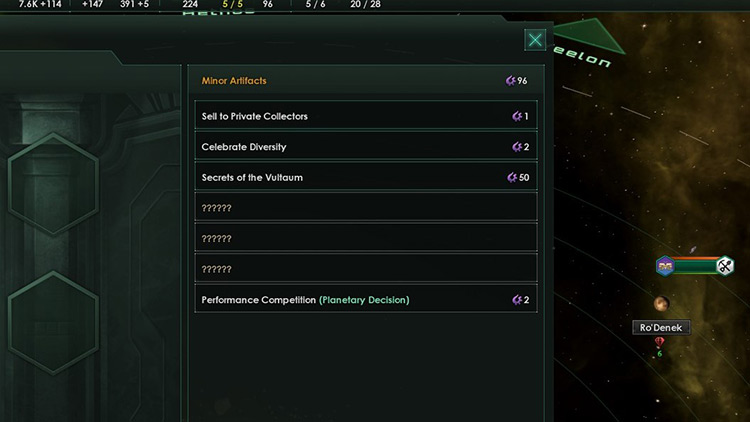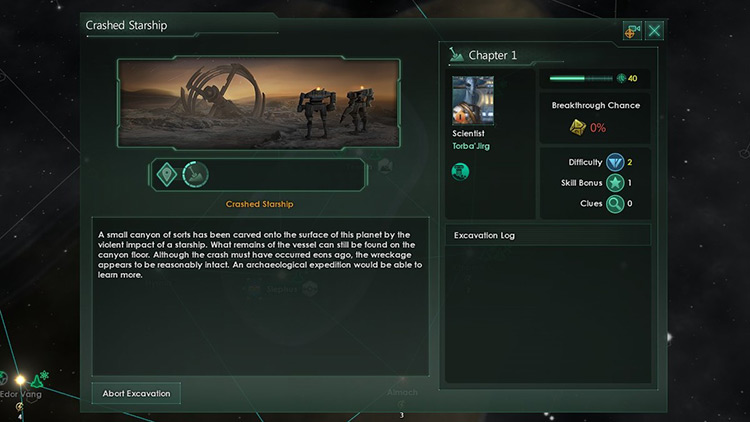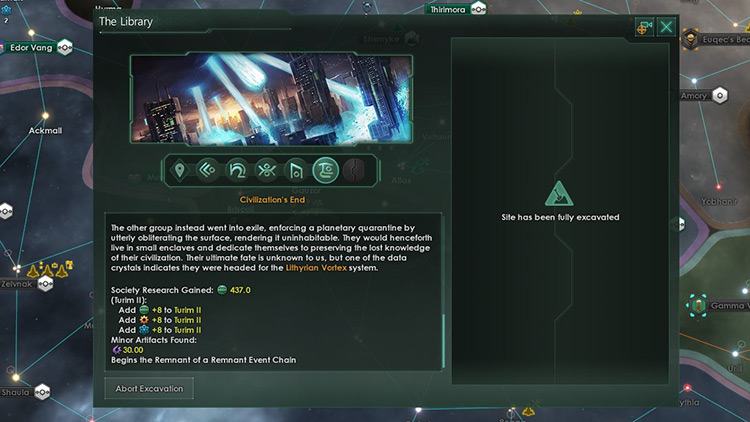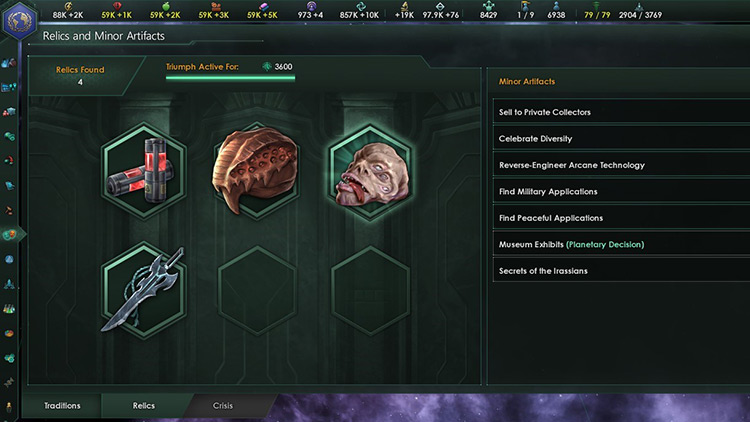You can exchange artifacts for unique bonuses to your empire. They also help unlock progress for Special Project event chains, like the L-Gates and the Irassians. Note: Artifacts are only available if the Ancient Relics DLC is enabled.
What Exactly Are Artifacts?
Artifacts, or Minor Artifacts, are a unique resource in Stellaris. Unlike other resources, however, you don’t earn them passively each month. Instead you will have to find them, mostly from excavating Archaeological Sites. Artifacts can be used in the “Society Management” screen, under the “Relics” tab. You can access Society Management by pressing F8, or by selecting it on the game menu left of the screen. Here’s a list of bonuses and how many Artifacts you will need to activate them: Note: Artifacts can be hard to find in the later stages of the game, so spend them wisely. Another very specific use for Artifacts is in the late game, when you’ve started building Megastructures, Stellaris’ version of wonders, namely the Mega Art Installation. You will need 100 Artifacts in order to fully upgrade the Mega Art Installation Megastructure.
Where To Get Artifacts
As mentioned before, Artifacts are a finite resource in Stellaris. They can be found through excavating Archaeological Sites, from random events, from Caravaneers, and from certain Relics. But each method has its drawbacks, so securing Artifacts is never convenient.
Method 1: Archaeological Sites
Excavation of Archaeological Sites will be your main source of Artifacts. It is the most reliable source in the game, though not always the quickest. These special points of interest can be discovered while surveying. Archaeological Sites could already be in place from the start in certain planets or discovered years after you’ve colonized a planet. You have a 1.25% chance of finding an Archaeological Site while surveying a planet. Your chances are decreased to 0.25% for 5 years after you’ve discovered a new site. To excavate an Archaeological Site: Note: The Archaeological Site needs to be within your borders before you can excavate it. The Excavation will have 1 to 6 “Chapters”, with each Chapter having its own set of narratives and rewards. How long your Science Ship unlocks each Excavation Chapter depends on the Archaeological Site’s difficulty and the expertise level of the Scientist assigned to the site. After a set amount of time, the Scientist excavating will make a “Roll”. Each Roll could have the following outcomes:
Nothing happens Gain 1 Clue Gain 2 Clues Special Event Breakthrough (You finish the Chapter and gain the rewards)
For every Clue you gain for that chapter, the chances of getting nothing decreases, while the chances of getting a breakthrough increases.
Method 2: Caravaneers
Another way you can gain Artifacts is through Caravaneers. Caravaneers are special factions that visit your empire from time to time. They offer you trade deals, and sometimes, they might sell you 5 Artifacts in exchange for 300 Alloys. This method isn’t very reliable, but if you’re lucky enough that a Caravan would visit and they are selling, then you should buy. Note: You will need the MegaCorp DLC for Caravaneers to visit.
Method 3: Relics
Some Relics also give your empire a lump sum of Artifacts, though you’ll need to find them first, and they will have a cooldown of 3,600 in-game days. The Relics in question are the Rubricator, which gives 30 Artifacts, and the Galatron, which also has a chance to give 30 Artifacts.
What Are Relics?
Relics are powerful artifacts that also act as trophies whenever you finish a Crisis or certain event chains. Each Relic has a passive effect and an active effect, also known in-game as a “Triumph” effect. You can activate a Relic’s Triumph effect using resources. Note: You can only activate one Relic at a time every 3,600 in-game days. Each Triumph effect is empire-wide. Here is a list of the Relics you can find in Stellaris:



